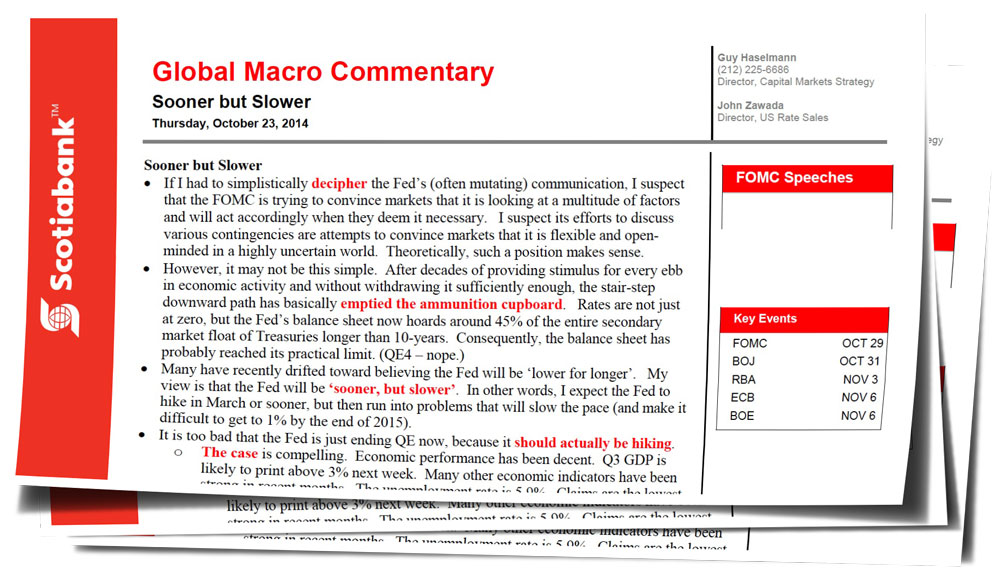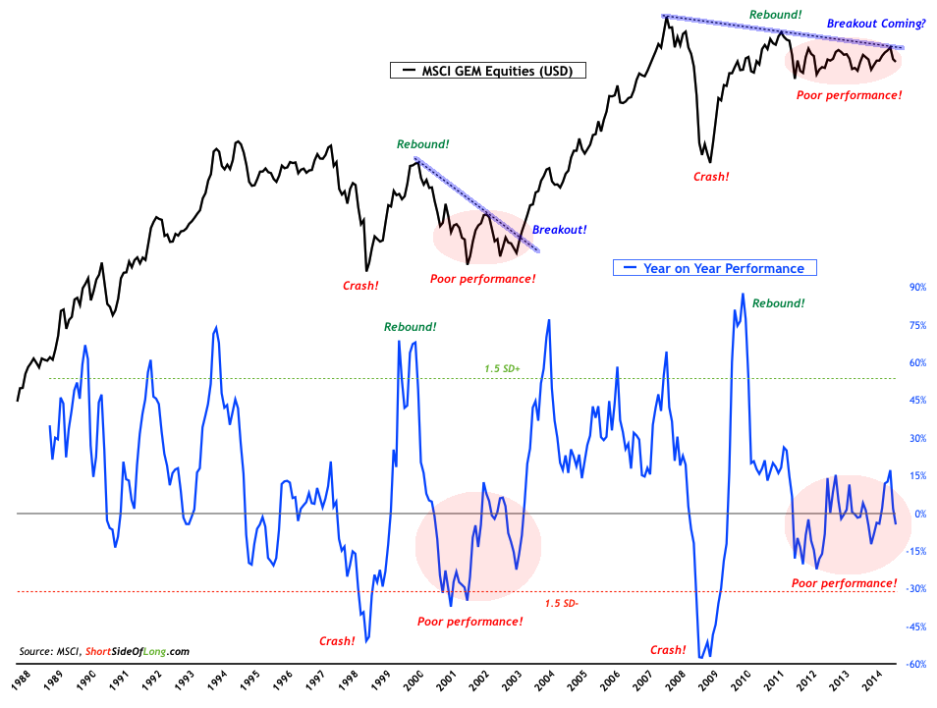Sooner but Slower
by Guy Haselmann, Director, Capital Markets Strategy, Scotiabank GBM
• If I had to simplistically decipher the Fed’s (often mutating) communication, I suspect that the FOMC is trying to convince markets that it is looking at a multitude of factors and will act accordingly when they deem it necessary. I suspect its efforts to discuss various contingencies are attempts to convince markets that it is flexible and open-minded in a highly uncertain world. Theoretically, such a position makes sense.
• However, it may not be this simple. After decades of providing stimulus for every ebb in economic activity and without withdrawing it sufficiently enough, the stair-step downward path has basically emptied the ammunition cupboard. Rates are not just at zero, but the Fed’s balance sheet now hoards around 45% of the entire secondary market float of Treasuries longer than 10-years. Consequently, the balance sheet has probably reached its practical limit. (QE4 – nope.)
• Many have recently drifted toward believing the Fed will be ‘lower for longer’. My view is that the Fed will be ‘sooner, but slower’. In other words, I expect the Fed to hike in March or sooner, but then run into problems that will slow the pace (and make it difficult to get to 1% by the end of 2015).
• It is too bad that the Fed is just ending QE now, because it should actually be hiking.
o The case is compelling. Economic performance has been decent. Q3 GDP is likely to print above 3% next week. Many other economic indicators have been strong in recent months. The unemployment rate is 5.9%. Claims are the lowest in over a decade. Market interest rates are low. The S&P 500 is only about 3% off its all-time high. Inflation has been stable. Oil has fallen 25% since July.
o Moreover, today’s equity market ‘melt-up’ should be a warning sign to the Fed of the moral hazard, one-way, bubble-like conditions it has instigated.
o I warned an equity market ‘melt-up’ might be the necessary warning sign that ultimately extracts the FOMC from its overly-aggressive accommodative stance (see “Yellen, Regulation, and Bubbles note from 11/15/2013). Moreover, I outlined in my “Cold Turkey” note from 10/15/2014, the numerous reasons why current Fed policies have been or have become counter-productive.
o Domestic factors supporting an early hike are all aligned. While international factors are more troubling, those countries are taking their own action to confront their own domestic challenges. Other geo-political uncertainties surrounding Ebola, the Middle East turmoil, or terrorism always exist, so they cannot be weighed too heavily.
• By waiting until March or later, the Fed could miss its ideal window of opportunity to hike, because concerns today could easily morph into full-blown global crises next year.
• In the meantime, ‘lower for longer’ hopes have propelled markets into a state of melt-up euphoria. I suspect that this perception will be reversed at next week’s FOMC meeting, when forward guidance –i.e., the words “considerable time” - are removed from the statement; and as acknowledgments of the improving state of the economy are added.
• It was not a change to the domestic economic landscape that triggered the shift in Fed expectations to ‘lower for longer’. The main factor was last week’s violent ‘risk-off’ trade which was triggered by a leap in uncertainties due to fears of Ebola and the potential for a renewed Eurozone crisis. It was also due to portfolio P&L and margin call problems resulting from enormous volatility in currency and commodity prices (particularly in oil).
• One consequence was a flight into the safety of Treasuries. Those fears have since partially receded (for the moment). However, the rise in uncertainties led the market to price-out several Fed hikes that were expected in 2015. One lesson is that in a highly uncertain and quickly changing world, and fragile economic environments, it is too dangerous to price-in too many hikes too soon. Yet, it may also be unwise to completely price-out all hikes before June 2015 and then use that pricing to justify a shift in FOMC expectations.
• As such, I recommend investors replace ‘lower for longer’ with “sooner but slower”.
• I still maintain my view that (commodity-like) long-dated Treasuries will move to lower yields over time (for the reasons outlined so frequently in earlier notes).
o Tactically, however, there will be times when legging into a curve flattening trade makes sense to protect the core long against a re-pricing event; e.g., the employment report, a FOMC meeting or an early hike (or next week’s GDP). After the event passes, I would cover the front end short and resume with the long-only position until the other reasons I’ve outlined in earlier notes play out. (I might even be right for different reasons, but so far so good.)
“Now everything’s a little upside down, as a matter of fact the wheels have stopped, what’s good is bad, what’s bad is good, you’ll find out when you reach the top, you’re on the bottom.” – Bob Dylan
Regards,
Guy
Guy Haselmann | Director, Capital Markets Strategy
▬▬▬▬▬▬▬▬▬▬▬▬▬▬▬▬▬▬▬▬▬▬▬▬▬▬▬
Scotiabank | Global Banking and Markets
250 Vesey Street | New York, NY 10281
T-212.225.6686 | C-917-325-5816
guy.haselmann[at]scotiabank.com
Scotiabank is a business name used by The Bank of Nova Scotia
Copyright © Scotiabank GBM














